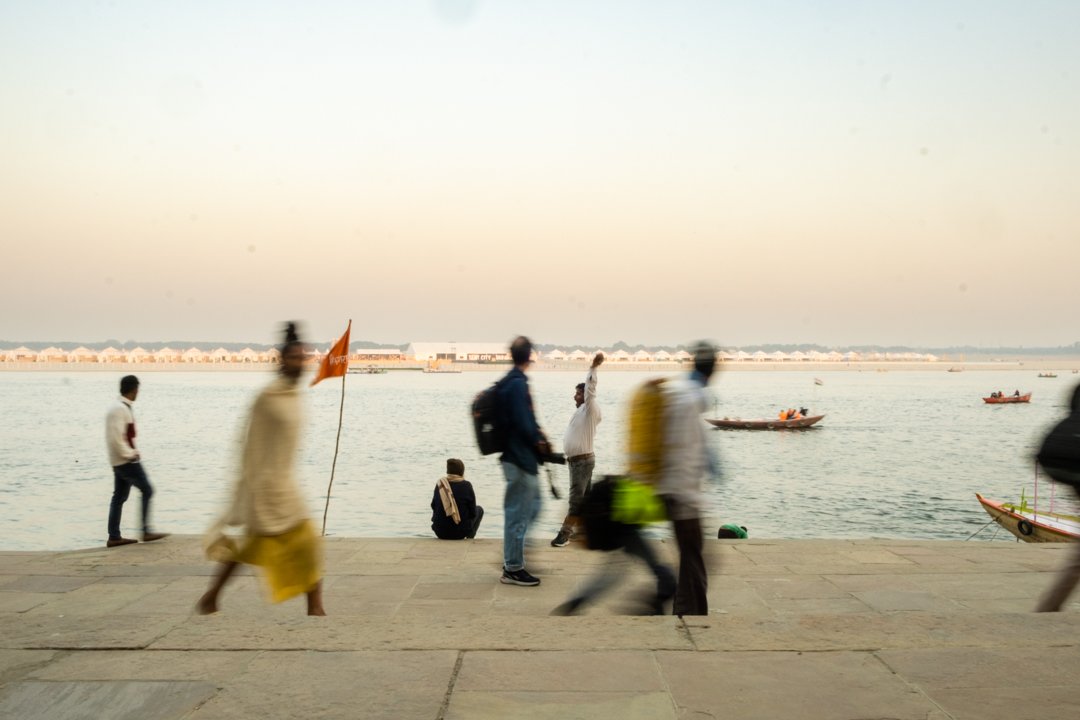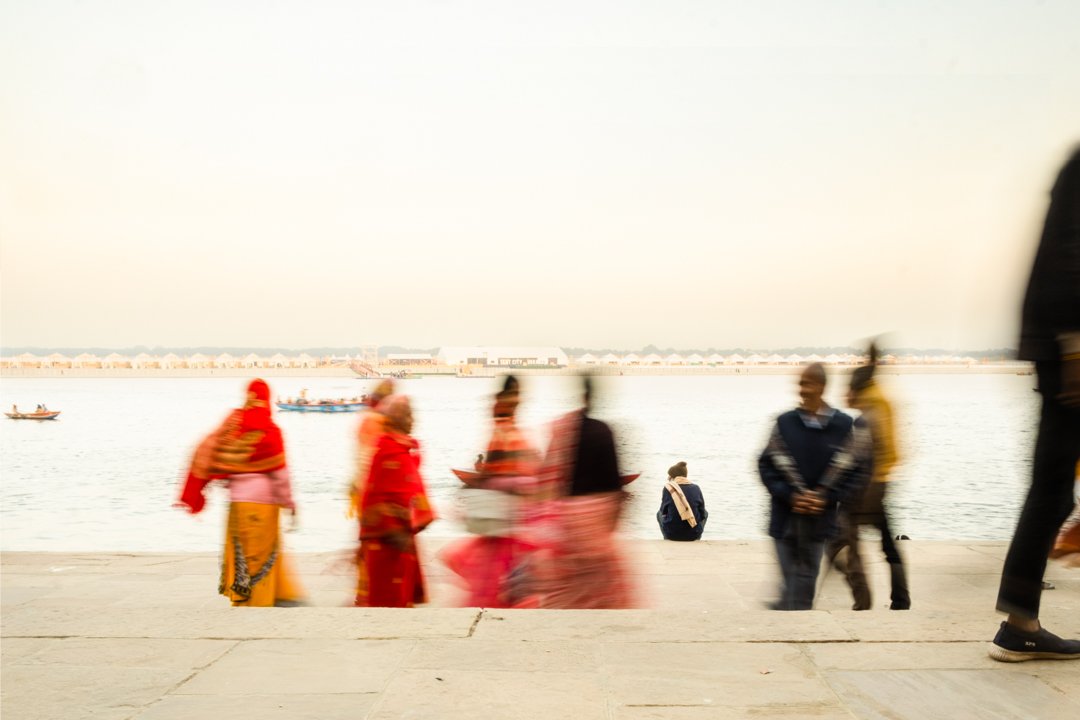Wishing for something completely different, we located Hue Abandoned Water Park. It sounded interesting on-line but wasn’t quite the secret it was made out to be. Once a bustling aquatic playground, nestled amidst the pine hills of Hue, this water park spans an area of 50 hectares.
Read Moretravel blog
Room with a view.
Make Hay While the Sun Shines - Vietnamese Proverb. Trang An. Ninh Binh.
Our homestay comprised of a group of bungalows on stilts nestled into the rock face. There were animals everywhere. It is very beautiful, but very, very wet.
Read MoreListen to your heart Spirit Speaks - Om Cafe slogan, Varanasi
Behind the ghats in the old, wonky, interlaced narrow alleys, the shops have been hit hard by covid and some traders are struggling to rebuild their lives. So many closed factories have killed the shopkeepers’ supply chains. Many have had to try and create new businesses. During Lockdown, some alleys have been brightly decorated. Building works are plentiful, the machinery isn’t.
If you don’t have a cow, milk is delivered straight to your jug - with a smile.
Some of the ghats are quieter and are a lovely place to sit and watch the world go by.




Our final evening in Varanasi had to be spent on the water again, this time we wanted to see the other side of the Ganges…
This has to be the biggest change we have seen here. We were shocked when we arrived to see what has become ‘the elephant in the room’ to the locals - Tent City, built by The Yogi Government over the other side of the river Ganges. What an empty, expensive eyesore. Created to cash in on the luxury end of the tourist industry and was inaugurated by PM Modi on the 13th Jan 2023. The tent city that resembles the sand dunes in Jaisalmer and Rann of Kutch in Gujarat apparently will showcase products from the East.
Apparently according to a newspaper ‘Tent City will add a new chapter to the tourism industry of the eastern UP and will bring financial benefits to the local people. The Tent City on the banks of the river Ganges will be a new chapter in the confluence of religion, spirituality and culture’.
I’m not wholly convinced. When I witness the numerous local boatsmen working so hard to make a living being overshadowed by huge Tent City party boats almost bullying them off the water, it doesn’t really enhance the culture or the spirituality of the place.
The locals still bathe, pray and play over this side but they are kept well away from Tent City. It is also where the families give up the cremated ashes to the holy river.
As we bid farewell to Varanasi, we spent our last evening on the water again with a local boatman. It gave us an opportunity to see the banks on other side of the Ganges.
We’ve tried hard to peel back a few more layers of this complicated city. It is breathtaking, frustrating, unique, chaotic and mesmerising and I doubt it will ever really face up to modernity.
Goodbye Varanasi, we have a plane to catch…
Every Supermodels Favourite Ramp - Indigo Airlines aeroplane ramp. Gwalior Airport.
From Gwalior military airport, on a flight lasting no longer than it takes to eat the complimentary pot noodle we landed in Varanasi.
Our last experience flying here had left a permanent scar, so it was an almighty relief that we encountered no issues and arrived as scheduled to the same place we resided last time - Panchkote Ghat. We returned because we never saw the Ghats, they were completely submerged. Three years ago the late monsoon suddenly hit. We left with the water up to our waists, balanced on our luggage, on a rickshaw being pushed by Ranjeet and friends through the waist deep water.
This time it’s warm and dry, perfect for us to explore life on the Ghats.
Situated on the banks are the ghats, the stairs going down to a river, which create the character of Varanasi. The ghats span the length of the entire bank and you can walk along the river by weaving up and down the steps. The stairs themselves slide into the water at the bottom, with the last visible step determined by the water levels of Ganges. At several points on the ghats are large landings where much of the activity takes place.
From families gathering, picnicking, taking selfies, sleeping to bathing, praying, learning, burning and boat building it all happens here from dawn until dusk.
One of the world’s oldest continually inhabited cities. Known by three names: Varanasi - the official more recent name deriving from two Ganges tributaries forming the city's borders - Varuna and Assi. Secondly, Banaras - the old name and finally, Kashi - the ancient name found in the primary Hindu texts meaning “to shine” and shine it certainly does.
By late afternoon some ghats start to fill up in readiness for the evening ahead. Snacks, Chai, sweets, candles and flowers are readily available.
We took a boat as dusk began to settle. It was beautiful to see Varanasi from the water.
We travelled along many of the ghats finally reaching Manikarnika Ghat the biggest of the burning ghats. Between here and Harishchandra, the smaller burning ghat there are about 80 cremations a day each costing 4000 rupees. In covid a cremation cost 6000 Rps due to the risk to the people who work here at the burning ghats.
The new spires, gleaming in the evening light, indicate the modern sleek new walkway completed during Lockdown leading up to the Golden Temple. Three years ago it was just a pile of mud, with many newly discovered temples randomly sticking up out of the ground.
As darkness fell, we moored up at Dasashwamedh Ghat to witness the evening Ganga Arti. This happens every evening, every day of the week. It was held on the roof tops when we were last here so it was exciting to the Arti in all its glory.
Approximately 20,000 people gathered. It was quite a spectacle to see the boats of all sizes pushing and shunting to get their space. Afterwards it was quite a spectacle to see everyone trying to leave. 20,000 people is a lot to battle through.
Of course an easier option is to stop and have a bite to eat.
No Bag No Homework - School Notice. Jaipur
The Jantar Mantar is an astronomical observatory in Jaipur, built in the early 18th century. It includes an impressive set of twenty main instruments featuring the largest sundials in the world, created predominantly from stone. Designed for the observation of astronomical positions with the naked eye, they embody several architectural and instrumental innovations.
Each instrument has a specific function for astronomical measurements. As the sun shines on the giant sundials it’s possible to read the time from the scales. A set of smaller stone instruments each represent the signs of the zodiac.
Some instruments were used to plot how the latitude changes over the course of a year. Each day was plotted but the shadow and read from the grid.
The Jantar Mantar was the vision of a scholarly prince showcasing his knowledge of astronomy and views on cosmology, at the end of the Mughal period.
The observatory became a meeting point for different scientific cultures and gave rise to widespread social practices linked to cosmology. It was also a symbol of royal authority, through its shear scale, it’s control of time, and its astrological forecasting capacities.